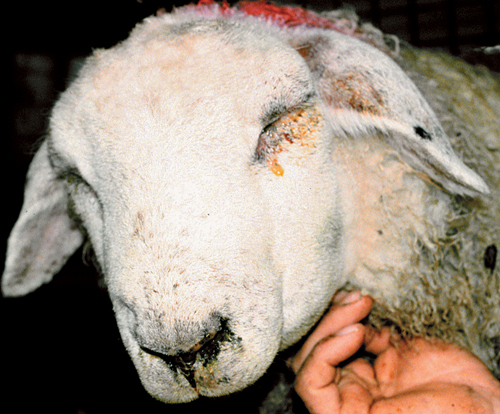Difference between revisions of "Sheep Medicine Q&A 10"
Jump to navigation
Jump to search
m |
|||
| Line 17: | Line 17: | ||
*dog bite to the face or similar wound/cellulitis | *dog bite to the face or similar wound/cellulitis | ||
*bluetongue | *bluetongue | ||
| − | |l1= | + | |l1= Photosensitisation |
|q2=What are the possible causes? | |q2=What are the possible causes? | ||
|a2= | |a2= | ||
| Line 23: | Line 23: | ||
*Primary photosensitization results when an ingested photodynamic agent in the animal’s body (hypericin from St. John’s Wort (''Hypericum perforatum'') is often quoted) is exposed to ultraviolet light causing fluorescence and death of cells in the skin. The cell necrosis and dermatitis is characteristically most severe in nonpigmented skin. <br><br> | *Primary photosensitization results when an ingested photodynamic agent in the animal’s body (hypericin from St. John’s Wort (''Hypericum perforatum'') is often quoted) is exposed to ultraviolet light causing fluorescence and death of cells in the skin. The cell necrosis and dermatitis is characteristically most severe in nonpigmented skin. <br><br> | ||
*Secondary (hepatogenous) photosensitization results from the liver’s inability to excrete phylloerythrin, a breakdown product of chlorophyll. In New Zealand facial eczema is caused by ingestion of the hepatotoxin, sporidesmin, produced by the saprophytic fungus ''Pithomyces chartarum''. | *Secondary (hepatogenous) photosensitization results from the liver’s inability to excrete phylloerythrin, a breakdown product of chlorophyll. In New Zealand facial eczema is caused by ingestion of the hepatotoxin, sporidesmin, produced by the saprophytic fungus ''Pithomyces chartarum''. | ||
| − | |l2= | + | |l2= Photosensitisation |
|q3=What treatment would you administer? | |q3=What treatment would you administer? | ||
|a3=Treatment includes removing the source of photosensitizing agent if identifiable and protecting the animal from direct sunlight by housing. <br><br> | |a3=Treatment includes removing the source of photosensitizing agent if identifiable and protecting the animal from direct sunlight by housing. <br><br> | ||
| Line 29: | Line 29: | ||
Topical emollients and antimicrobials may help soften and protect the skin. <br><br> | Topical emollients and antimicrobials may help soften and protect the skin. <br><br> | ||
Systemic antibiotics are indicated in cases of a secondary bacterial dermatitis. | Systemic antibiotics are indicated in cases of a secondary bacterial dermatitis. | ||
| − | |l3= | + | |l3= Photosensitisation |
|q4=What control measures would you introduce? | |q4=What control measures would you introduce? | ||
|a4= In the absence of recognized plant species, primary photosensitization occurs sporadically and there are no specific control measures. | |a4= In the absence of recognized plant species, primary photosensitization occurs sporadically and there are no specific control measures. | ||
| − | |l4= | + | |l4= Photosensitisation |
</FlashCard> | </FlashCard> | ||
Latest revision as of 15:31, 21 July 2011
| This question was provided by Manson Publishing as part of the OVAL Project. See more Sheep questions |
A white-faced sheep grazing a new grass ley presents with swollen oedematous head and ears. Clinical examination reveals lacrimation, and sensitive erythematous non-pigmented skin with oozing of serum. The rectal temperature is normal.
| Question | Answer | Article | |
| What conditions would you consider? (Most likely first) | The most likely conditions to consider include:
|
Link to Article | |
| What are the possible causes? | Photosensitization is most evident in animals with nonpigmented skin.
|
Link to Article | |
| What treatment would you administer? | Treatment includes removing the source of photosensitizing agent if identifiable and protecting the animal from direct sunlight by housing. Parenteral corticosteroids are indicated in the acute erythematous stage of photosensitization to reduce oedema/inflammation. |
Link to Article | |
| What control measures would you introduce? | In the absence of recognized plant species, primary photosensitization occurs sporadically and there are no specific control measures.
|
Link to Article | |
